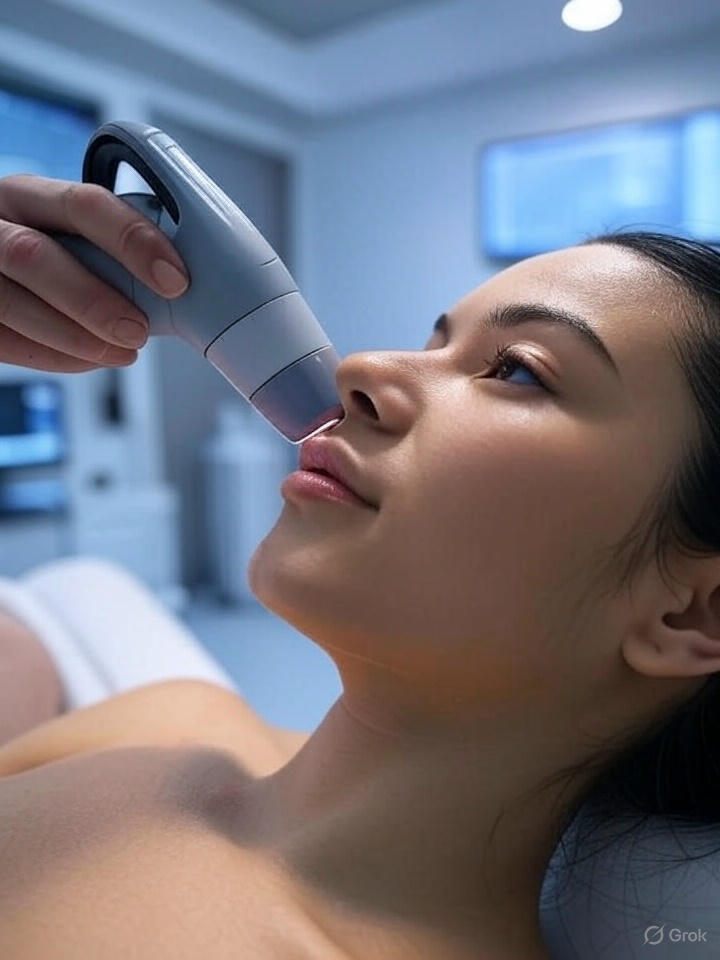What is Low-Level Laser Therapy (LLLT)?
Low-Level Laser Therapy (LLLT) is a non-invasive treatment that uses low-powered lasers or light-emitting diodes (LEDs) to stimulate hair follicles and encourage hair growth. The therapy is typically administered through a device such as a laser comb, cap, or helmet that emits red light at specific wavelengths. This light penetrates the scalp and is believed to enhance cellular activity, improving blood flow, and promoting the natural regeneration of hair follicles.
LLLT is FDA-approved for the treatment of androgenetic alopecia (pattern baldness) in both men and women, making it a recognized and viable option for individuals experiencing hair thinning or loss.
How Does LLLT Work?
The mechanism behind LLLT’s effectiveness lies in its ability to stimulate the mitochondria of hair follicles. When the light is absorbed by the scalp, it increases cellular activity, leading to an increase in the production of adenosine triphosphate (ATP), the energy currency of cells. This energy boost promotes healthier hair growth by stimulating hair follicles that may have become dormant due to genetic factors or aging.
Studies suggest that LLLT can:
- Increase blood circulation to the scalp.
- Reduce inflammation around the hair follicles.
- Encourage the growth phase of hair follicles (anagen phase).
- Increase the size of miniaturized hair follicles, making them healthier and more capable of producing thicker hair.
Is LLLT Effective for Hair Growth?
Several clinical studies have demonstrated the effectiveness of LLLT in treating hair loss. Research indicates that individuals who use LLLT consistently over a period of months may experience an increase in hair density, improved hair thickness, and slower hair loss. However, results can vary from person to person, depending on factors such as the severity of hair loss, the type of hair loss, and individual response to the therapy.
While LLLT can promote hair regrowth and improve the overall health of hair, it is important to understand that results may not be immediate. Most individuals require consistent use of the therapy for several months to see noticeable improvements.
Is LLLT a Permanent Solution?
Unfortunately, LLLT is not a permanent solution to hair loss. While it can provide significant benefits, such as hair regrowth and slowing down hair loss, the effects tend to be temporary. For long-lasting results, ongoing treatment is necessary. Once the therapy is stopped, the benefits may gradually diminish, and hair loss could resume.
In fact, many dermatologists recommend using LLLT in conjunction with other treatments for hair loss, such as minoxidil (Rogaine) or finasteride (Propecia), to maximize results and prolong the effects.
It’s important to note that the effectiveness of LLLT also depends on the individual’s type of hair loss. LLLT is more effective for individuals with androgenetic alopecia (genetic hair loss), but it may not be as beneficial for those suffering from other types of hair loss, such as alopecia areata or scarring alopecia.
Benefits of LLLT
- Non-invasive and Safe: Unlike hair transplant surgery, LLLT is a non-invasive procedure with minimal side effects. It’s generally considered safe for most people.
- Convenience: LLLT can be performed at home using devices like laser combs or caps, providing convenience and flexibility for users.
- No Downtime: Treatment sessions are short (typically around 20-30 minutes) and require no recovery time.
Potential Drawbacks
- Temporary Results: As mentioned earlier, LLLT is not a permanent fix for hair loss, and the benefits may diminish once the treatment is discontinued.
- Varied Effectiveness: Not everyone responds to LLLT in the same way, and results can vary.
- Cost: While LLLT devices are available for at-home use, they can be expensive, and long-term use can add up over time.
Conclusion
Low-Level Laser Therapy (LLLT) offers a promising option for individuals looking to slow down hair loss and promote hair regrowth. However, it is not a permanent solution. For lasting results, ongoing treatment is necessary, and combining LLLT with other hair loss treatments may enhance effectiveness. It’s important to have realistic expectations and understand that the therapy’s benefits will diminish if stopped. If you are considering LLLT, consulting a healthcare provider or dermatologist can help determine if it’s the right choice for your specific hair loss condition. learn more here – https://drrakib.com.au/treatments/hair-loss-treatment/

